University Business Analysis Report: Nike Inc. and Kodak Company
VerifiedAdded on 2020/04/13
|9
|1576
|35
Report
AI Summary
This report provides a comprehensive analysis of Nike Inc. and Kodak Company, examining their market strategies, decision-making processes, and the impact of environmental forces. The report utilizes PESTLE and SWOT analyses to evaluate each company's strengths, weaknesses, opportunities, and threats. It explores how Nike has leveraged strategic management to compete in the sports equipment market, addressing challenges like inventory management and ethical concerns. The analysis of Kodak delves into its transition from analog to digital, highlighting the challenges posed by intense competition and the rise of smartphones. The report concludes with recommendations for both companies, emphasizing the adoption of modern technology, strategic management teams, and product innovation to adapt to market changes and maintain relevance. The analysis draws on various sources to provide a detailed understanding of the companies' market positions and strategic approaches.
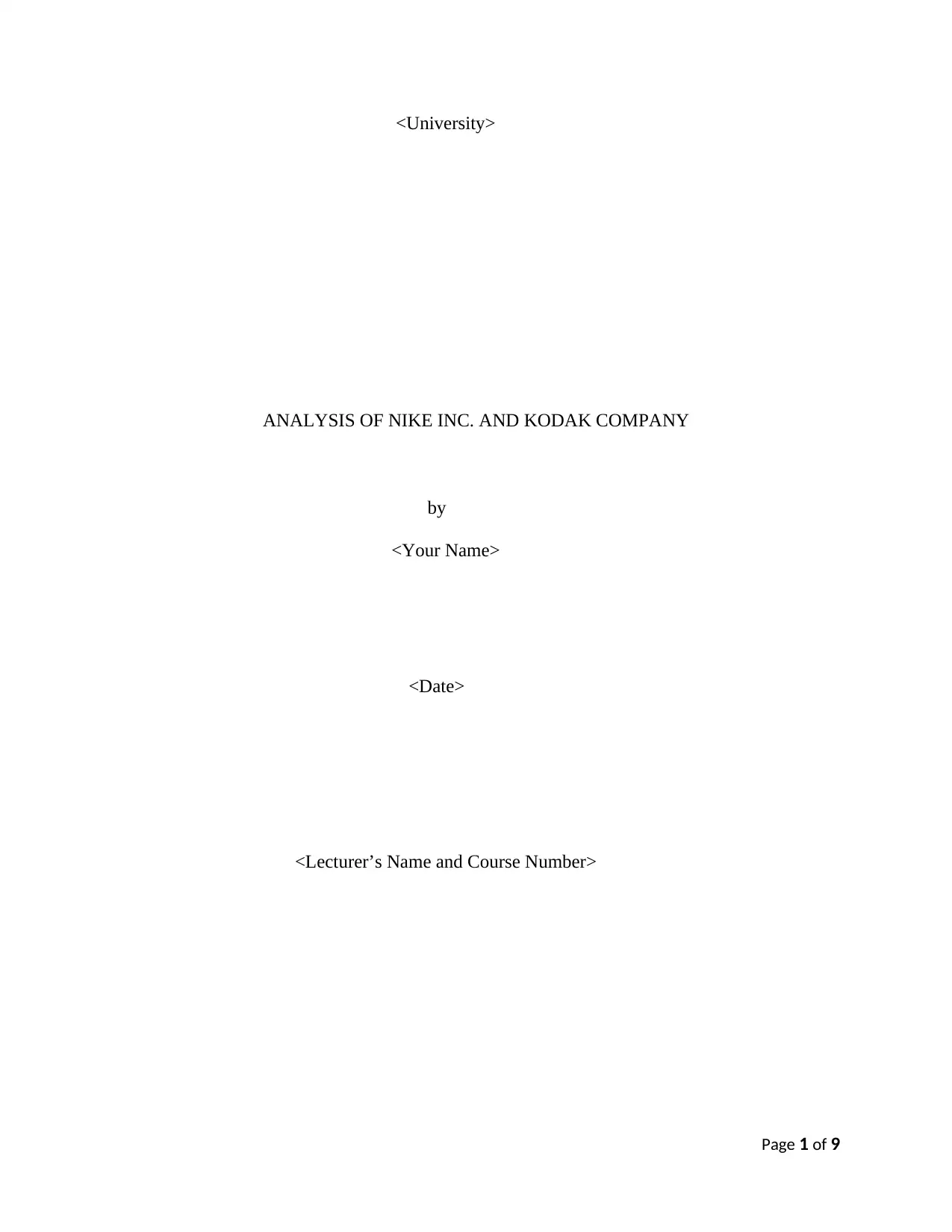
<University>
ANALYSIS OF NIKE INC. AND KODAK COMPANY
by
<Your Name>
<Date>
<Lecturer’s Name and Course Number>
Page 1 of 9
ANALYSIS OF NIKE INC. AND KODAK COMPANY
by
<Your Name>
<Date>
<Lecturer’s Name and Course Number>
Page 1 of 9
Paraphrase This Document
Need a fresh take? Get an instant paraphrase of this document with our AI Paraphraser
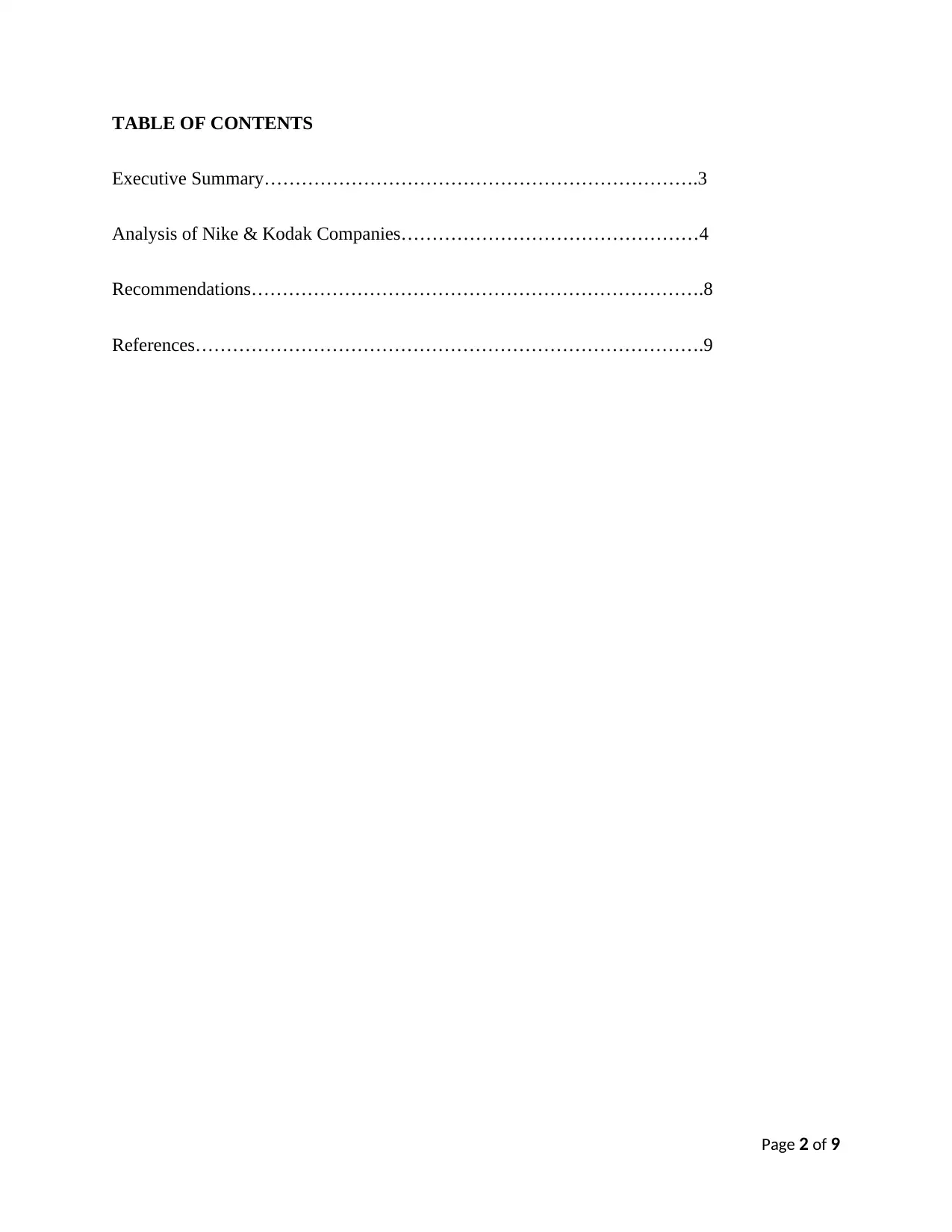
TABLE OF CONTENTS
Executive Summary…………………………………………………………….3
Analysis of Nike & Kodak Companies…………………………………………4
Recommendations……………………………………………………………….8
References……………………………………………………………………….9
Page 2 of 9
Executive Summary…………………………………………………………….3
Analysis of Nike & Kodak Companies…………………………………………4
Recommendations……………………………………………………………….8
References……………………………………………………………………….9
Page 2 of 9
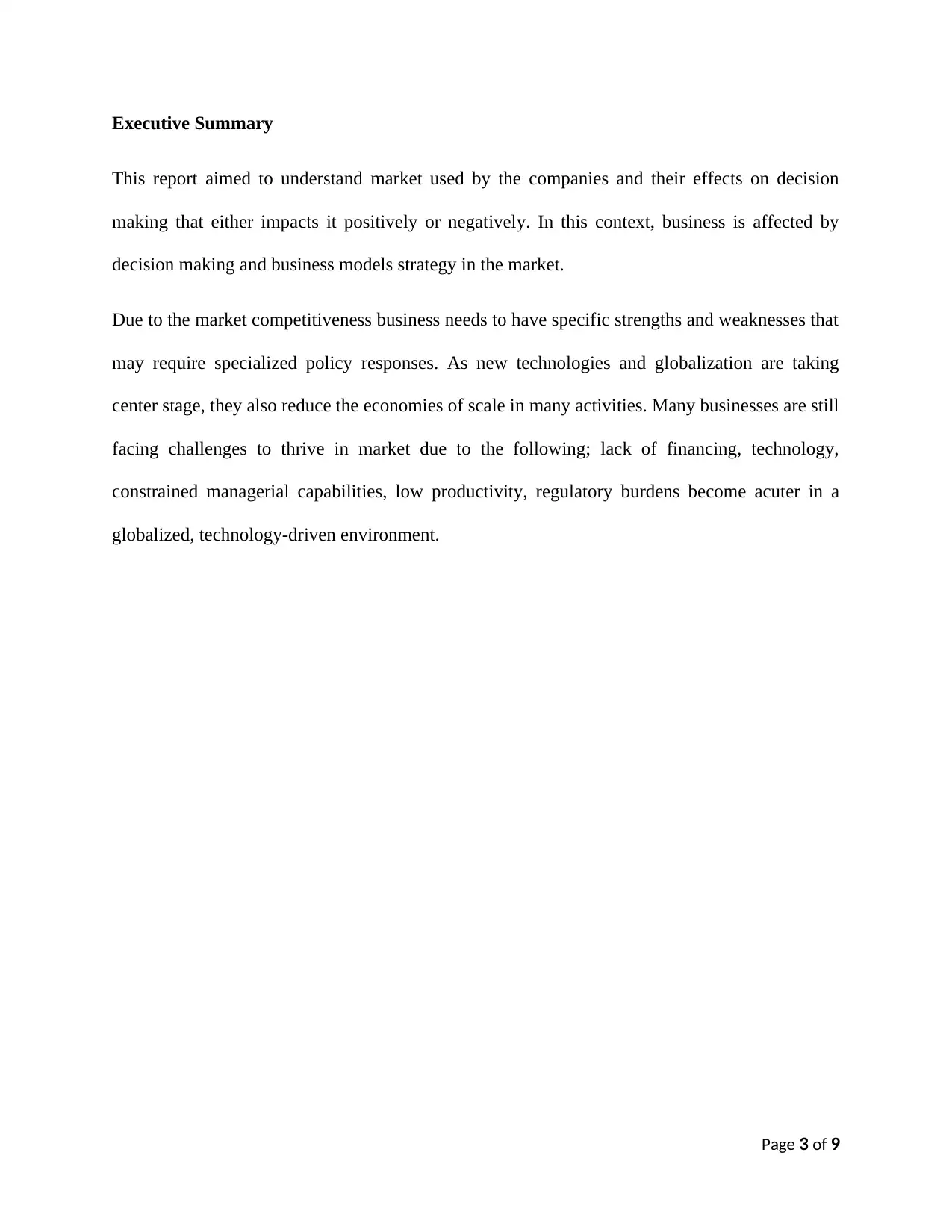
Executive Summary
This report aimed to understand market used by the companies and their effects on decision
making that either impacts it positively or negatively. In this context, business is affected by
decision making and business models strategy in the market.
Due to the market competitiveness business needs to have specific strengths and weaknesses that
may require specialized policy responses. As new technologies and globalization are taking
center stage, they also reduce the economies of scale in many activities. Many businesses are still
facing challenges to thrive in market due to the following; lack of financing, technology,
constrained managerial capabilities, low productivity, regulatory burdens become acuter in a
globalized, technology-driven environment.
Page 3 of 9
This report aimed to understand market used by the companies and their effects on decision
making that either impacts it positively or negatively. In this context, business is affected by
decision making and business models strategy in the market.
Due to the market competitiveness business needs to have specific strengths and weaknesses that
may require specialized policy responses. As new technologies and globalization are taking
center stage, they also reduce the economies of scale in many activities. Many businesses are still
facing challenges to thrive in market due to the following; lack of financing, technology,
constrained managerial capabilities, low productivity, regulatory burdens become acuter in a
globalized, technology-driven environment.
Page 3 of 9
⊘ This is a preview!⊘
Do you want full access?
Subscribe today to unlock all pages.

Trusted by 1+ million students worldwide
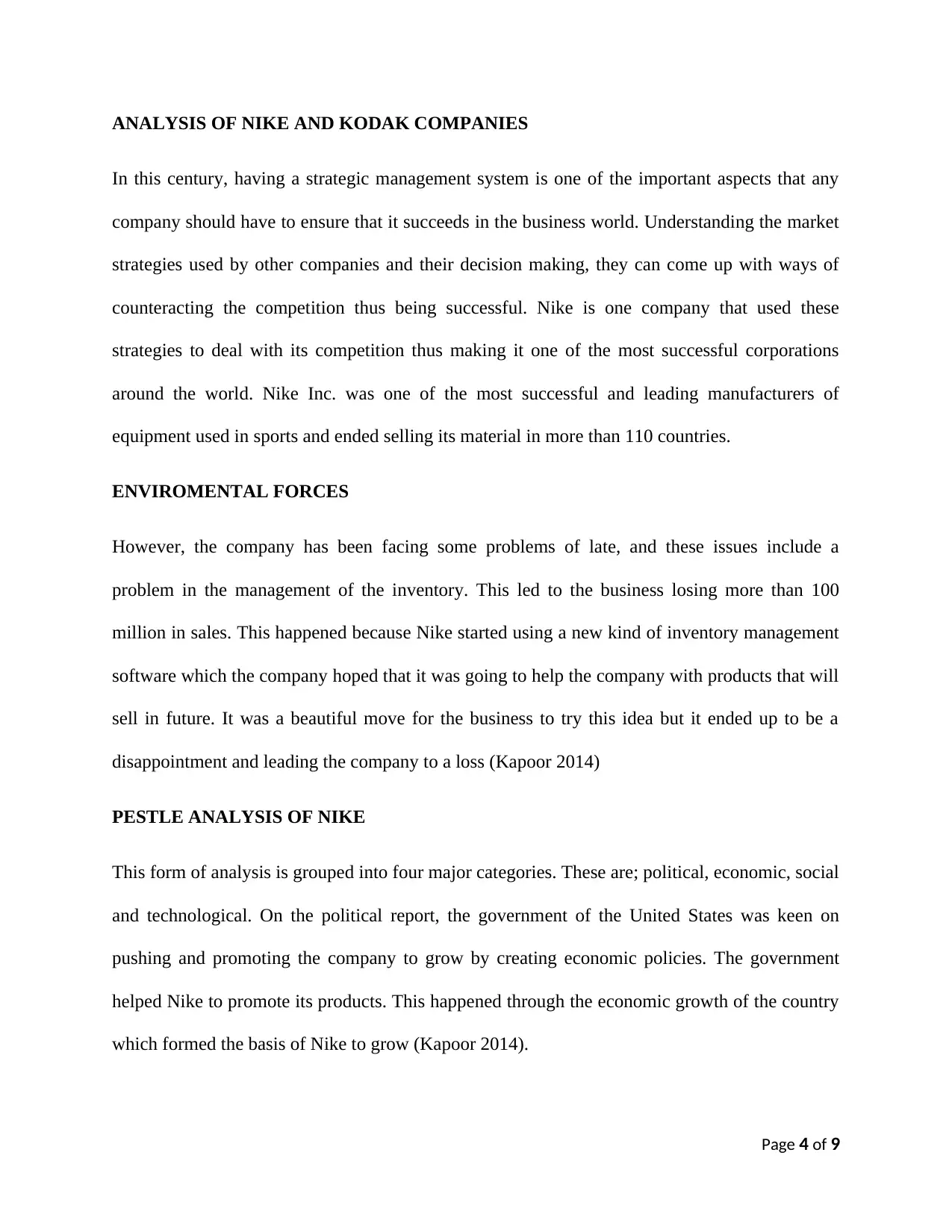
ANALYSIS OF NIKE AND KODAK COMPANIES
In this century, having a strategic management system is one of the important aspects that any
company should have to ensure that it succeeds in the business world. Understanding the market
strategies used by other companies and their decision making, they can come up with ways of
counteracting the competition thus being successful. Nike is one company that used these
strategies to deal with its competition thus making it one of the most successful corporations
around the world. Nike Inc. was one of the most successful and leading manufacturers of
equipment used in sports and ended selling its material in more than 110 countries.
ENVIROMENTAL FORCES
However, the company has been facing some problems of late, and these issues include a
problem in the management of the inventory. This led to the business losing more than 100
million in sales. This happened because Nike started using a new kind of inventory management
software which the company hoped that it was going to help the company with products that will
sell in future. It was a beautiful move for the business to try this idea but it ended up to be a
disappointment and leading the company to a loss (Kapoor 2014)
PESTLE ANALYSIS OF NIKE
This form of analysis is grouped into four major categories. These are; political, economic, social
and technological. On the political report, the government of the United States was keen on
pushing and promoting the company to grow by creating economic policies. The government
helped Nike to promote its products. This happened through the economic growth of the country
which formed the basis of Nike to grow (Kapoor 2014).
Page 4 of 9
In this century, having a strategic management system is one of the important aspects that any
company should have to ensure that it succeeds in the business world. Understanding the market
strategies used by other companies and their decision making, they can come up with ways of
counteracting the competition thus being successful. Nike is one company that used these
strategies to deal with its competition thus making it one of the most successful corporations
around the world. Nike Inc. was one of the most successful and leading manufacturers of
equipment used in sports and ended selling its material in more than 110 countries.
ENVIROMENTAL FORCES
However, the company has been facing some problems of late, and these issues include a
problem in the management of the inventory. This led to the business losing more than 100
million in sales. This happened because Nike started using a new kind of inventory management
software which the company hoped that it was going to help the company with products that will
sell in future. It was a beautiful move for the business to try this idea but it ended up to be a
disappointment and leading the company to a loss (Kapoor 2014)
PESTLE ANALYSIS OF NIKE
This form of analysis is grouped into four major categories. These are; political, economic, social
and technological. On the political report, the government of the United States was keen on
pushing and promoting the company to grow by creating economic policies. The government
helped Nike to promote its products. This happened through the economic growth of the country
which formed the basis of Nike to grow (Kapoor 2014).
Page 4 of 9
Paraphrase This Document
Need a fresh take? Get an instant paraphrase of this document with our AI Paraphraser
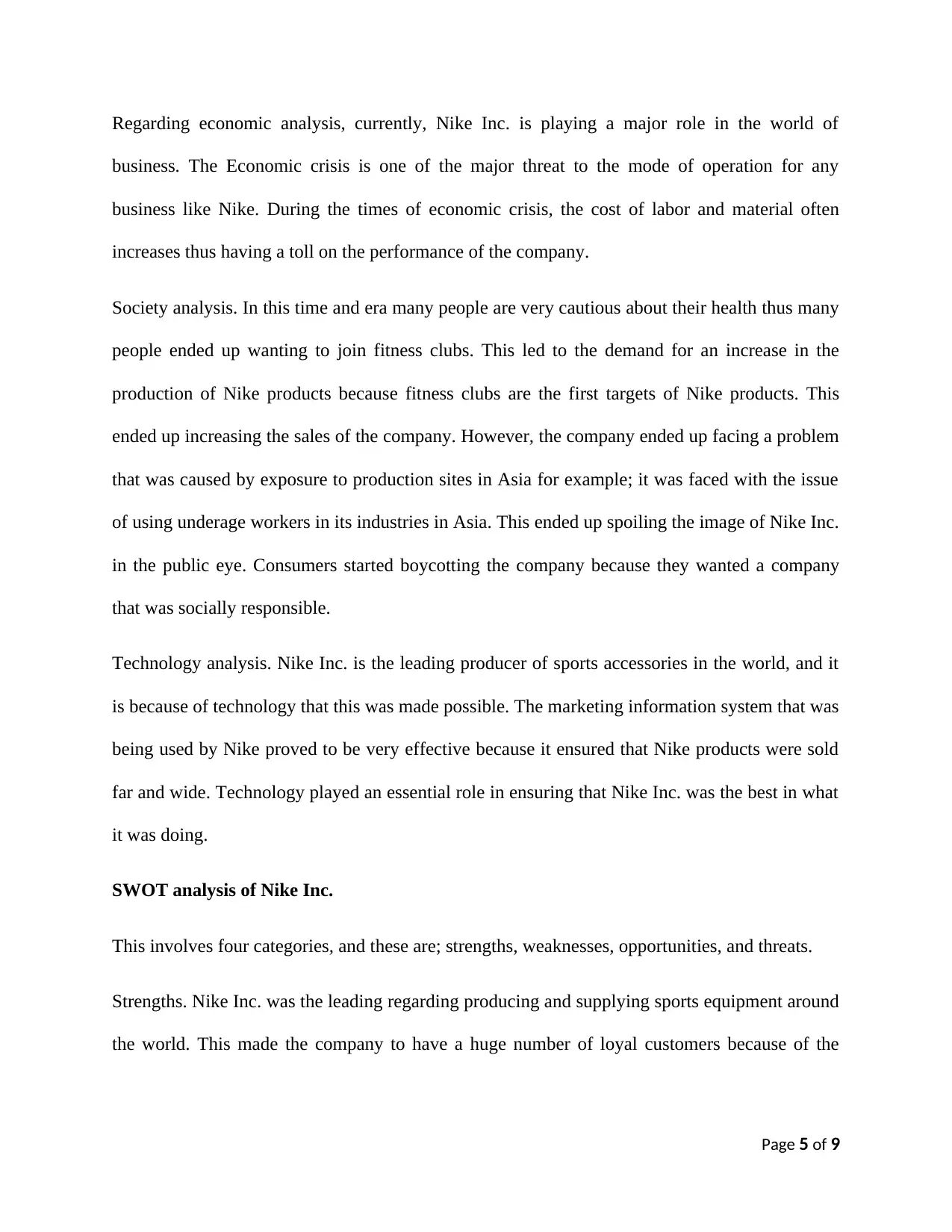
Regarding economic analysis, currently, Nike Inc. is playing a major role in the world of
business. The Economic crisis is one of the major threat to the mode of operation for any
business like Nike. During the times of economic crisis, the cost of labor and material often
increases thus having a toll on the performance of the company.
Society analysis. In this time and era many people are very cautious about their health thus many
people ended up wanting to join fitness clubs. This led to the demand for an increase in the
production of Nike products because fitness clubs are the first targets of Nike products. This
ended up increasing the sales of the company. However, the company ended up facing a problem
that was caused by exposure to production sites in Asia for example; it was faced with the issue
of using underage workers in its industries in Asia. This ended up spoiling the image of Nike Inc.
in the public eye. Consumers started boycotting the company because they wanted a company
that was socially responsible.
Technology analysis. Nike Inc. is the leading producer of sports accessories in the world, and it
is because of technology that this was made possible. The marketing information system that was
being used by Nike proved to be very effective because it ensured that Nike products were sold
far and wide. Technology played an essential role in ensuring that Nike Inc. was the best in what
it was doing.
SWOT analysis of Nike Inc.
This involves four categories, and these are; strengths, weaknesses, opportunities, and threats.
Strengths. Nike Inc. was the leading regarding producing and supplying sports equipment around
the world. This made the company to have a huge number of loyal customers because of the
Page 5 of 9
business. The Economic crisis is one of the major threat to the mode of operation for any
business like Nike. During the times of economic crisis, the cost of labor and material often
increases thus having a toll on the performance of the company.
Society analysis. In this time and era many people are very cautious about their health thus many
people ended up wanting to join fitness clubs. This led to the demand for an increase in the
production of Nike products because fitness clubs are the first targets of Nike products. This
ended up increasing the sales of the company. However, the company ended up facing a problem
that was caused by exposure to production sites in Asia for example; it was faced with the issue
of using underage workers in its industries in Asia. This ended up spoiling the image of Nike Inc.
in the public eye. Consumers started boycotting the company because they wanted a company
that was socially responsible.
Technology analysis. Nike Inc. is the leading producer of sports accessories in the world, and it
is because of technology that this was made possible. The marketing information system that was
being used by Nike proved to be very effective because it ensured that Nike products were sold
far and wide. Technology played an essential role in ensuring that Nike Inc. was the best in what
it was doing.
SWOT analysis of Nike Inc.
This involves four categories, and these are; strengths, weaknesses, opportunities, and threats.
Strengths. Nike Inc. was the leading regarding producing and supplying sports equipment around
the world. This made the company to have a huge number of loyal customers because of the
Page 5 of 9
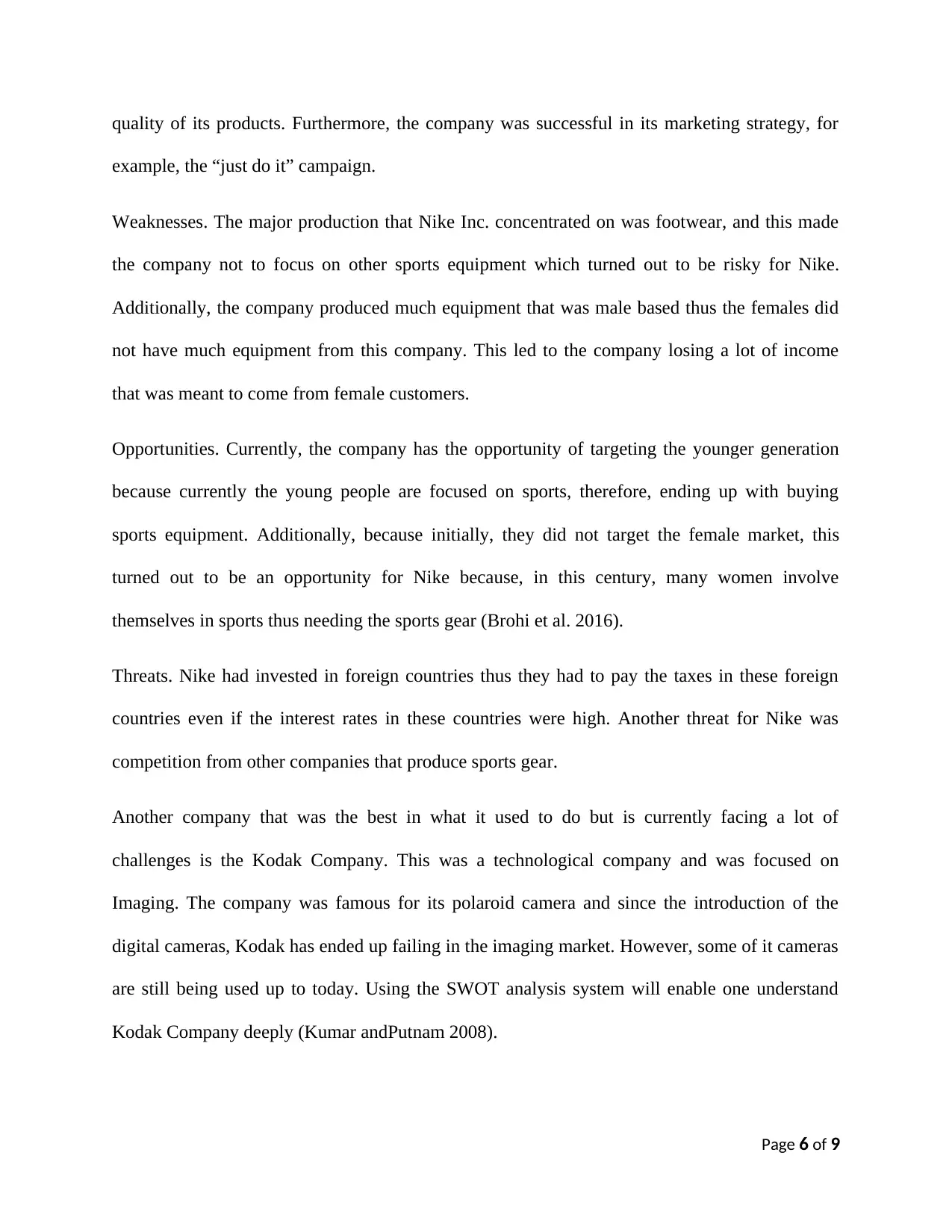
quality of its products. Furthermore, the company was successful in its marketing strategy, for
example, the “just do it” campaign.
Weaknesses. The major production that Nike Inc. concentrated on was footwear, and this made
the company not to focus on other sports equipment which turned out to be risky for Nike.
Additionally, the company produced much equipment that was male based thus the females did
not have much equipment from this company. This led to the company losing a lot of income
that was meant to come from female customers.
Opportunities. Currently, the company has the opportunity of targeting the younger generation
because currently the young people are focused on sports, therefore, ending up with buying
sports equipment. Additionally, because initially, they did not target the female market, this
turned out to be an opportunity for Nike because, in this century, many women involve
themselves in sports thus needing the sports gear (Brohi et al. 2016).
Threats. Nike had invested in foreign countries thus they had to pay the taxes in these foreign
countries even if the interest rates in these countries were high. Another threat for Nike was
competition from other companies that produce sports gear.
Another company that was the best in what it used to do but is currently facing a lot of
challenges is the Kodak Company. This was a technological company and was focused on
Imaging. The company was famous for its polaroid camera and since the introduction of the
digital cameras, Kodak has ended up failing in the imaging market. However, some of it cameras
are still being used up to today. Using the SWOT analysis system will enable one understand
Kodak Company deeply (Kumar andPutnam 2008).
Page 6 of 9
example, the “just do it” campaign.
Weaknesses. The major production that Nike Inc. concentrated on was footwear, and this made
the company not to focus on other sports equipment which turned out to be risky for Nike.
Additionally, the company produced much equipment that was male based thus the females did
not have much equipment from this company. This led to the company losing a lot of income
that was meant to come from female customers.
Opportunities. Currently, the company has the opportunity of targeting the younger generation
because currently the young people are focused on sports, therefore, ending up with buying
sports equipment. Additionally, because initially, they did not target the female market, this
turned out to be an opportunity for Nike because, in this century, many women involve
themselves in sports thus needing the sports gear (Brohi et al. 2016).
Threats. Nike had invested in foreign countries thus they had to pay the taxes in these foreign
countries even if the interest rates in these countries were high. Another threat for Nike was
competition from other companies that produce sports gear.
Another company that was the best in what it used to do but is currently facing a lot of
challenges is the Kodak Company. This was a technological company and was focused on
Imaging. The company was famous for its polaroid camera and since the introduction of the
digital cameras, Kodak has ended up failing in the imaging market. However, some of it cameras
are still being used up to today. Using the SWOT analysis system will enable one understand
Kodak Company deeply (Kumar andPutnam 2008).
Page 6 of 9
⊘ This is a preview!⊘
Do you want full access?
Subscribe today to unlock all pages.

Trusted by 1+ million students worldwide
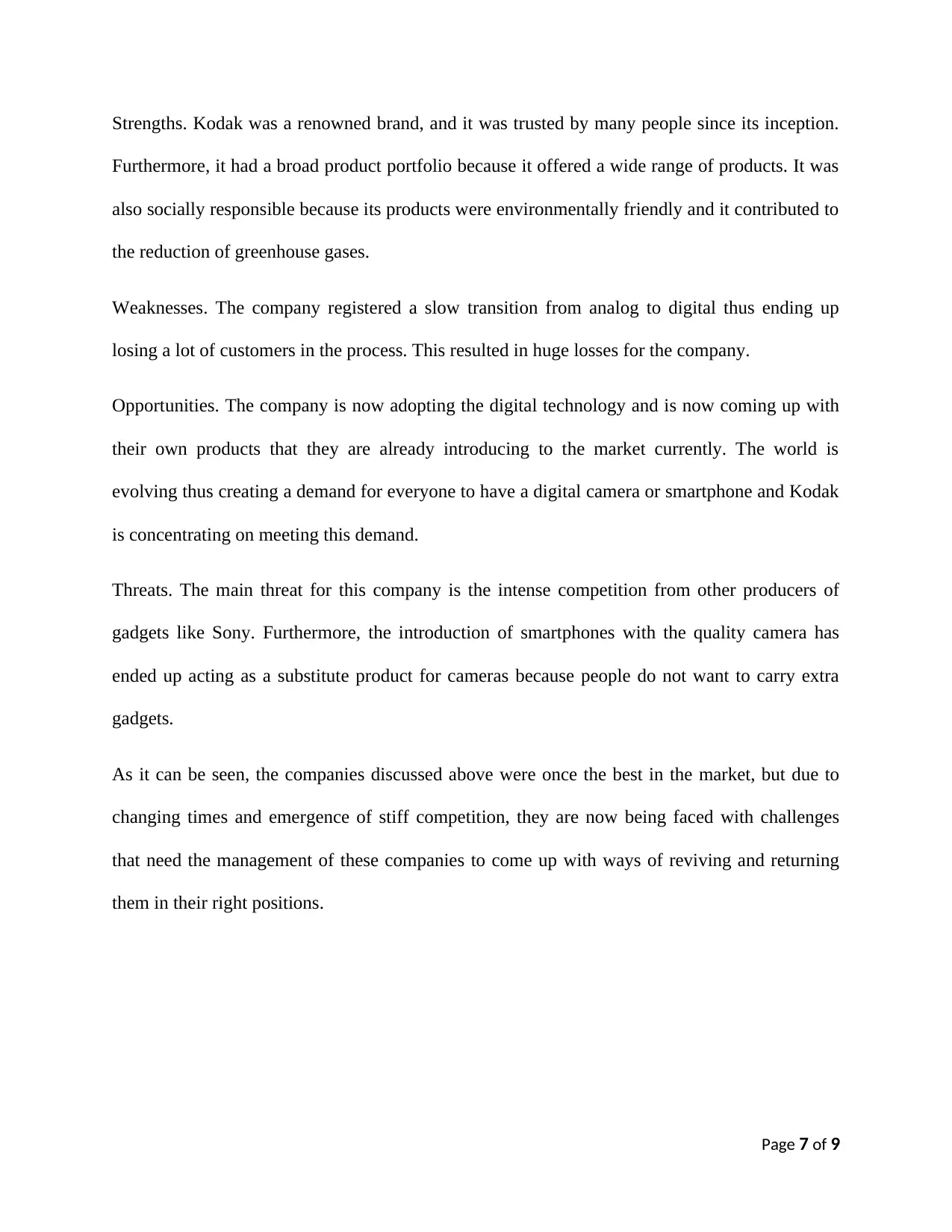
Strengths. Kodak was a renowned brand, and it was trusted by many people since its inception.
Furthermore, it had a broad product portfolio because it offered a wide range of products. It was
also socially responsible because its products were environmentally friendly and it contributed to
the reduction of greenhouse gases.
Weaknesses. The company registered a slow transition from analog to digital thus ending up
losing a lot of customers in the process. This resulted in huge losses for the company.
Opportunities. The company is now adopting the digital technology and is now coming up with
their own products that they are already introducing to the market currently. The world is
evolving thus creating a demand for everyone to have a digital camera or smartphone and Kodak
is concentrating on meeting this demand.
Threats. The main threat for this company is the intense competition from other producers of
gadgets like Sony. Furthermore, the introduction of smartphones with the quality camera has
ended up acting as a substitute product for cameras because people do not want to carry extra
gadgets.
As it can be seen, the companies discussed above were once the best in the market, but due to
changing times and emergence of stiff competition, they are now being faced with challenges
that need the management of these companies to come up with ways of reviving and returning
them in their right positions.
Page 7 of 9
Furthermore, it had a broad product portfolio because it offered a wide range of products. It was
also socially responsible because its products were environmentally friendly and it contributed to
the reduction of greenhouse gases.
Weaknesses. The company registered a slow transition from analog to digital thus ending up
losing a lot of customers in the process. This resulted in huge losses for the company.
Opportunities. The company is now adopting the digital technology and is now coming up with
their own products that they are already introducing to the market currently. The world is
evolving thus creating a demand for everyone to have a digital camera or smartphone and Kodak
is concentrating on meeting this demand.
Threats. The main threat for this company is the intense competition from other producers of
gadgets like Sony. Furthermore, the introduction of smartphones with the quality camera has
ended up acting as a substitute product for cameras because people do not want to carry extra
gadgets.
As it can be seen, the companies discussed above were once the best in the market, but due to
changing times and emergence of stiff competition, they are now being faced with challenges
that need the management of these companies to come up with ways of reviving and returning
them in their right positions.
Page 7 of 9
Paraphrase This Document
Need a fresh take? Get an instant paraphrase of this document with our AI Paraphraser
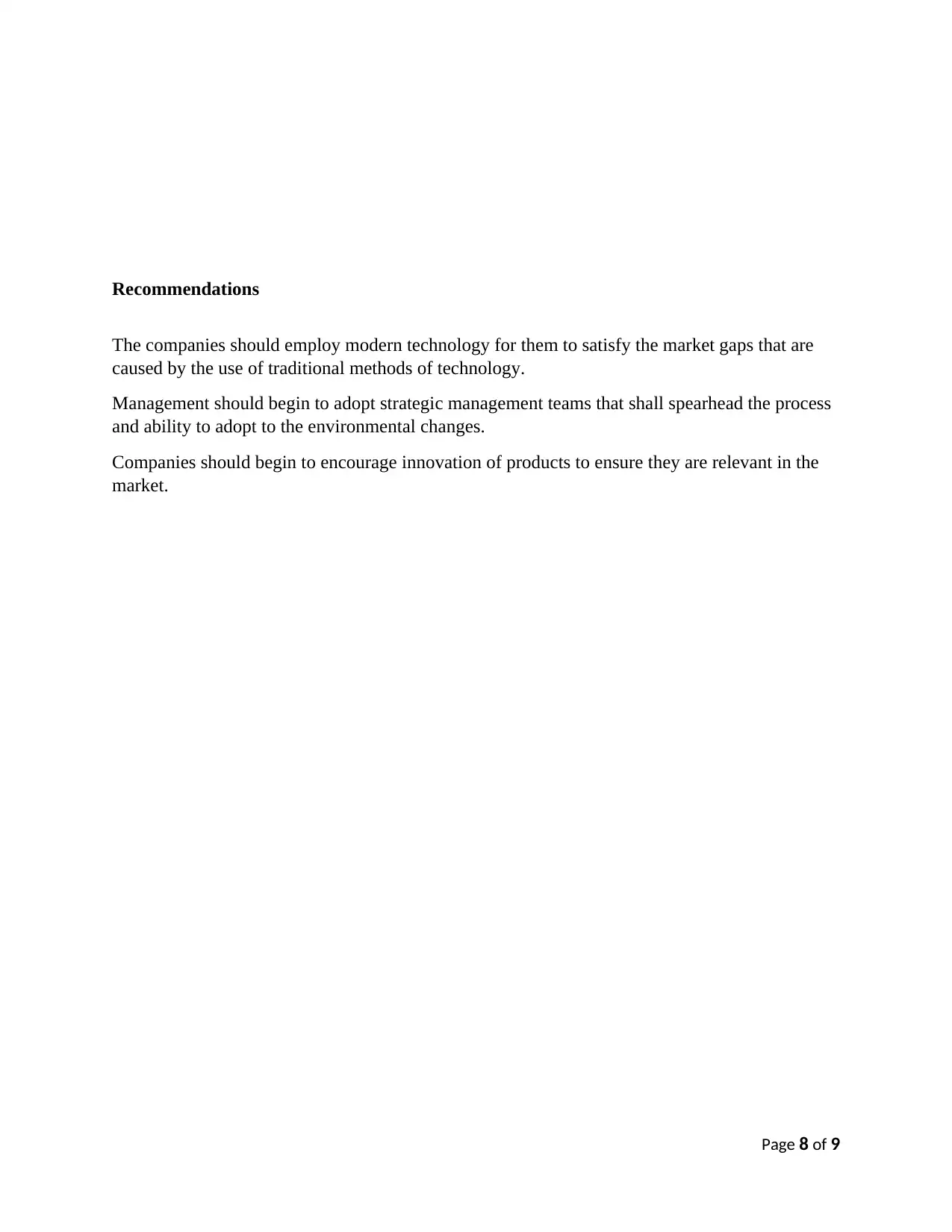
Recommendations
The companies should employ modern technology for them to satisfy the market gaps that are
caused by the use of traditional methods of technology.
Management should begin to adopt strategic management teams that shall spearhead the process
and ability to adopt to the environmental changes.
Companies should begin to encourage innovation of products to ensure they are relevant in the
market.
Page 8 of 9
The companies should employ modern technology for them to satisfy the market gaps that are
caused by the use of traditional methods of technology.
Management should begin to adopt strategic management teams that shall spearhead the process
and ability to adopt to the environmental changes.
Companies should begin to encourage innovation of products to ensure they are relevant in the
market.
Page 8 of 9
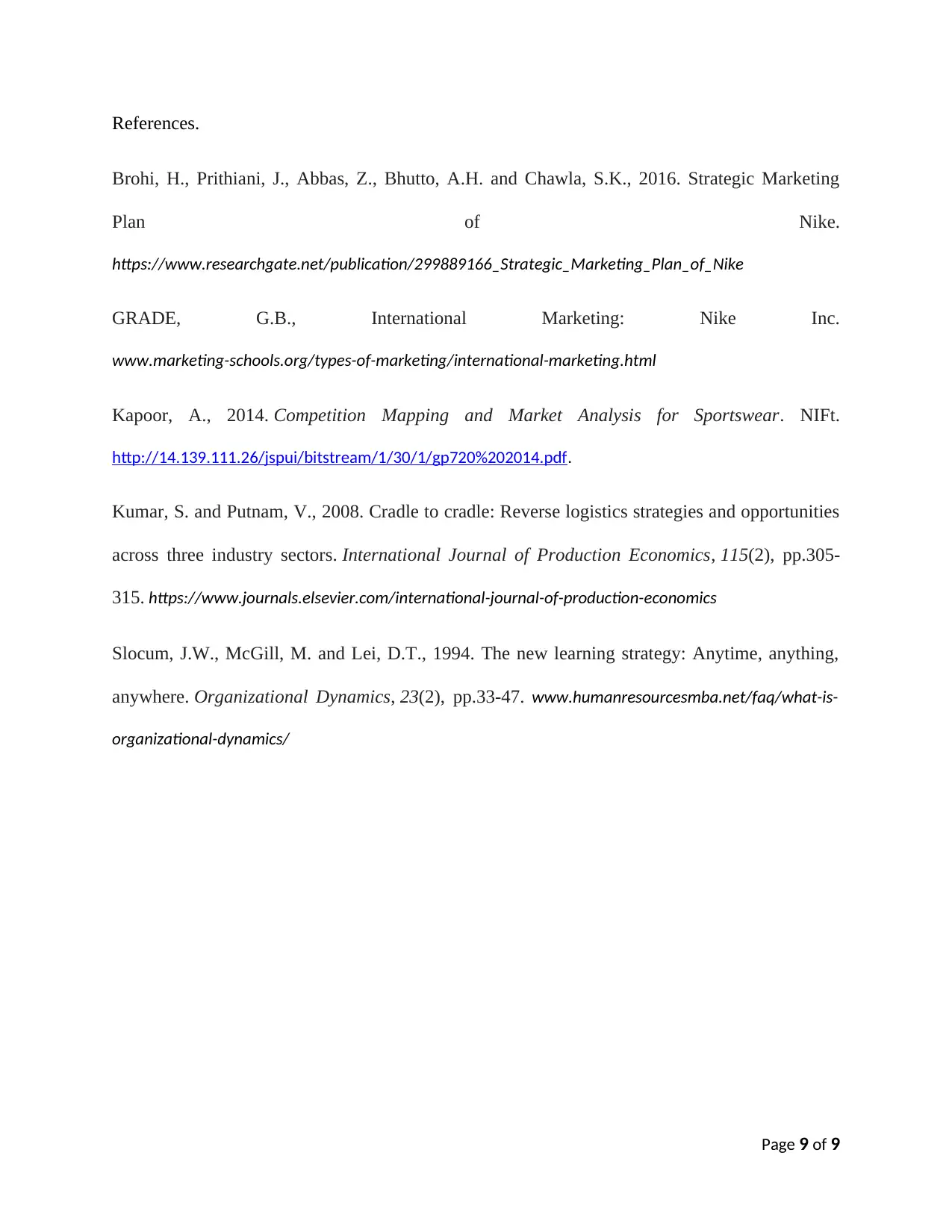
References.
Brohi, H., Prithiani, J., Abbas, Z., Bhutto, A.H. and Chawla, S.K., 2016. Strategic Marketing
Plan of Nike.
https://www.researchgate.net/publication/299889166_Strategic_Marketing_Plan_of_Nike
GRADE, G.B., International Marketing: Nike Inc.
www.marketing-schools.org/types-of-marketing/international-marketing.html
Kapoor, A., 2014. Competition Mapping and Market Analysis for Sportswear. NIFt.
http://14.139.111.26/jspui/bitstream/1/30/1/gp720%202014.pdf.
Kumar, S. and Putnam, V., 2008. Cradle to cradle: Reverse logistics strategies and opportunities
across three industry sectors. International Journal of Production Economics, 115(2), pp.305-
315. https://www.journals.elsevier.com/international-journal-of-production-economics
Slocum, J.W., McGill, M. and Lei, D.T., 1994. The new learning strategy: Anytime, anything,
anywhere. Organizational Dynamics, 23(2), pp.33-47. www.humanresourcesmba.net/faq/what-is-
organizational-dynamics/
Page 9 of 9
Brohi, H., Prithiani, J., Abbas, Z., Bhutto, A.H. and Chawla, S.K., 2016. Strategic Marketing
Plan of Nike.
https://www.researchgate.net/publication/299889166_Strategic_Marketing_Plan_of_Nike
GRADE, G.B., International Marketing: Nike Inc.
www.marketing-schools.org/types-of-marketing/international-marketing.html
Kapoor, A., 2014. Competition Mapping and Market Analysis for Sportswear. NIFt.
http://14.139.111.26/jspui/bitstream/1/30/1/gp720%202014.pdf.
Kumar, S. and Putnam, V., 2008. Cradle to cradle: Reverse logistics strategies and opportunities
across three industry sectors. International Journal of Production Economics, 115(2), pp.305-
315. https://www.journals.elsevier.com/international-journal-of-production-economics
Slocum, J.W., McGill, M. and Lei, D.T., 1994. The new learning strategy: Anytime, anything,
anywhere. Organizational Dynamics, 23(2), pp.33-47. www.humanresourcesmba.net/faq/what-is-
organizational-dynamics/
Page 9 of 9
⊘ This is a preview!⊘
Do you want full access?
Subscribe today to unlock all pages.

Trusted by 1+ million students worldwide
1 out of 9
Related Documents
Your All-in-One AI-Powered Toolkit for Academic Success.
+13062052269
info@desklib.com
Available 24*7 on WhatsApp / Email
![[object Object]](/_next/static/media/star-bottom.7253800d.svg)
Unlock your academic potential
Copyright © 2020–2025 A2Z Services. All Rights Reserved. Developed and managed by ZUCOL.





